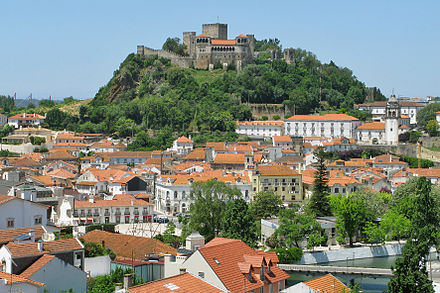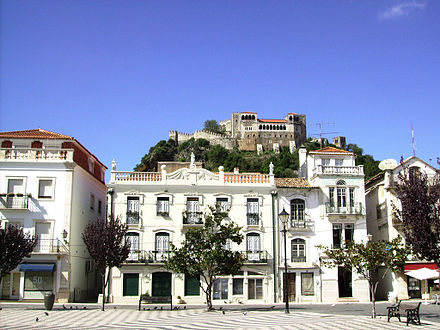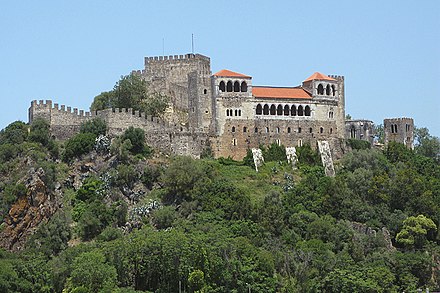Leiria - municipality and city in Portugal
Leiria is a city of 127,000 people (2011) in Beira Litoral in central Portugal. It is home to a restored medieval castle.
Understand
Leiria (lay-REE-uh, /ɫɐj.ˈɾi.ɐ/) municipality has 126,879 residents (2011).
History
 The region around Leiria was inhabited by a Celtiberian tribe, who established a settlement called "Collippo" around 7 km away. This settlement was occupied by the Romans, who expanded it. The stones of the ancient Roman town were used in the Middle Ages to build much of Leiria.
The region around Leiria was inhabited by a Celtiberian tribe, who established a settlement called "Collippo" around 7 km away. This settlement was occupied by the Romans, who expanded it. The stones of the ancient Roman town were used in the Middle Ages to build much of Leiria.
The Moors occupied the area until it was re-captured by the first King of Portugal, Afonso Henriques in 1135, during the Reconquista. South of Leiria in that period was the so-called "no-man's land", until regions further south (like Santarém and Lisbon) were permanently taken and re-populated by the Christians.
Afonso I of Portugal and Sancho I rebuilt the walls and the Leiria Castle to avoid new enemy incursions. Most of the population lived inside the protective city walls. The oldest church of Leiria, the Church of Saint Peter (Igreja de São Pedro), built in romanesque style in the last quarter of the 12th century, served the parish located outside the walls.
 During the Middle Ages the importance of the village increased, and it was the setting of several cortes (feudal parliaments). In the late 14th century, King John I built a royal palace within the walls of the castle of Leiria. This palace, with elegant gothic galleries that offered wonderful views of the town and surrounding landscape, was totally in ruins but was partially rebuilt in the 20th century. John I also sponsored the rebuilding in late gothic style of the old Church of Our Lady of the Rock (Igreja de Nossa Senhora da Pedra), located inside the castle. The Cathedral of Leiria was built in the second half of the 16th century in a mix of late manueline and mannerist styles.
During the Middle Ages the importance of the village increased, and it was the setting of several cortes (feudal parliaments). In the late 14th century, King John I built a royal palace within the walls of the castle of Leiria. This palace, with elegant gothic galleries that offered wonderful views of the town and surrounding landscape, was totally in ruins but was partially rebuilt in the 20th century. John I also sponsored the rebuilding in late gothic style of the old Church of Our Lady of the Rock (Igreja de Nossa Senhora da Pedra), located inside the castle. The Cathedral of Leiria was built in the second half of the 16th century in a mix of late manueline and mannerist styles.
 Compared to the Middle Ages, the subsequent history of Leiria is of relative decay. The city was stormed by the Peninsular War, namely in 1808 (the killing of Portela, by the troops of Gen. Margaron) and the Great Fire of 1811, caused by the Napoleonic troops retreating from the Lines of Torres Vedras. In the 20th century, however, its strategic position in the Portuguese territory favoured the development of a diversified industry.
Compared to the Middle Ages, the subsequent history of Leiria is of relative decay. The city was stormed by the Peninsular War, namely in 1808 (the killing of Portela, by the troops of Gen. Margaron) and the Great Fire of 1811, caused by the Napoleonic troops retreating from the Lines of Torres Vedras. In the 20th century, however, its strategic position in the Portuguese territory favoured the development of a diversified industry.
Climate
It has mild and wet winters, relying on average 45 days of rain (312 mm) versus 45 dry days and 5 hours of sun per day. The average temperatures range between 15 °C (59 °F) and 7 °C (45 °F) and can go below freezing (< 0 °C (32 °F)) on exceptionally colder days, favouring the onset of light frost or ice. Snowfalls in the city of Leiria typically occur once every 20 to 30 years.
Springs are pleasant, but very rainy during the month of April. This season has an average of 39 days of rain 273 mm (11 in) to 51 dry days and 7 hours of sunshine per day. The average temperatures range between 20 °C (68 °F) and 11 °C (52 °F).
The summers bring high temperatures and sunshine, counting on average 18 days of rain 77 mm (3 in) compared with 82 dry days and 9 hours of sunshine per day. Average temperatures range between 27 °C (81 °F) and 15 °C (59 °F), the maximum can reach 35 °C (95 °F) on the hottest days.
The autumn, although mild, sometimes plagues the city with rain and wind and has on average 36 days of rain 339 mm (13 in) compared to 54 dry days and 6 hours of sun per day. Average temperatures range between 21 °C (70 °F) and 12 °C (54 °F).
Visitor information
- Visite Leiria, Câmara Municipal de Leiria, Largo da República, 39.74102°, -8.8104°, +351 244 839 500, cmleiria@cm-leiria.pt. 2021-06-26
Get in
By plane
The nearest airports of Leiria are Portela airport (in Lisbon) and Francisco Sá Carneiro airport (in Oporto).
By train
There are daily connections between Paris and Lisbon (Sud-Express), entering by the Vilar Formoso border; between Lisbon and Madrid, by the Marvão border; and between Porto and Vigo (Spain), by the Valença border. Train lines: North (Pombal) or West (Leiria 4 km)
By bus
There are 3 bus companies linking Porto (Internorte), Lisbon (Intercentro) and Faro (Intersul) to several European cities.
By car
- National road: IC2 (Lisbon - Oporto)
- Motorway: A1 (Lisbon - Oporto) or A8 (Lisbon - Leiria)
Get around
See
- Castle (Castelo de Leiria), +351 244 839 670. closed for renovations as of Feb 2021. The castle of Leiria was built by D. Afonso Henriques in the 12th century to create a line of defence against the Arabs. The keep (Tower of Menagem) was begun in the 14th century. It was badly damaged during the French invasion, and restored in the early 20th century. 2021-02-15
- Museu de Leiria, Rua Tenente Valadim 41, 39.7416°, -8.8028°, +351 244 839 677. Daily 09:30 – 17:30. Civic museum housed in the 16th-century Convent of St. Agostinho. 2021-02-15
- Museu da Imagem em Movimento - mimo (Museum of the Moving Image), Largo de São Pedro 3 (Leiria Castle area), 39.7474°, -8.8072°, +351 244 839 675. Daily 09:30 – 17:30. Portugal's only Museum of the Moving Image. 2021-02-15
- Paper museum (Museu do moinho do papel), Rua Fábrica do Papel, n.º 13, 39.740556°, -8.800833°, +351 244 839 672. Apr-Sep: M-F 09:30 – 12:00, 14:30-17:00; Sa Su holidays 09:30 – 18:00; Oct-Mar: M-F 09:30 – 12:00, 14:30-17:00; Sa 14:30-17:00. At the site of Portugal's first paper mill. 2021-02-15
- Rivers Lis & Lena
- Pinhal (pinewood forest) de Leiria
- Beaches
- Viera de Leiria & S.Pedro de Muel.
Do
- Camping, enjoy the beaches, Berlengas isles, off the coast of Peniche (summer only).
- Castle of Leiria: As well as being a site of historical interest, the Castle of Leiria provides a venue for cultural events . Situated close to the castle, the Church of Saint Peter (Igreja de São Pedro) is used as the venue of Leiria's annual festival of music.
- Theaters/Cinema: The Theatre Miguel Franco in the market Sant'Ana (Mercado de Sant'Ana) and The Theatre José Lúcio da Silva are venues for theatre, music and dance performances, as well as cinema.
- Day & Night Life: The city is the birthplace of several leading Portuguese poets, such as Afonso Lopes Vieira and Francisco Rodrigues Lobo, after whom the central square (Praca Rodrigues Lobo) is named. Today the square is home to a thriving café culture, as well as being regularly used for cultural events. There's also many festivals in the region mostly in the summer.
Buy
The town hosts a monthly antiques market.
Eat
Leiria's gastronomy offers a good variety of Portuguese dishes including fresh fish dishes and the famous "Leitao" da Boavista (barbecued piglet).
The nearby village of Cortes is known for "Migas", a dish of corn bread with spinach, garlic and olive oil which is eaten as an accompaniment to fish or meat.
Local sweet pastry: Brisas do Liz and Lampreia d'Ovos which was originally made by the local convent.
- Casinha Velha, Morada: Rua Professores Portelas 23, Marrazes, 39.7594°, -8.8103°, +351 244 855 355, geral@casinhavelha.com. M–Sa 12:30–15:00 & 19:30–22:00, Su 12:30–15:00. Homey and rustic. A wine enthusiast's favourite. Michelin rated as Bib Gourmand for "good quality, good value cooking". €40-95 2021-06-26
- Coconuts Restaurante, Centro Comercial Dom Dinis Loja 606, Avenida Combatentes da Grande Guerra 42, 39.7429°, -8.8099°, +351 960 064 126, cyrano_leiria@hotmail.com. Tu–Sa 12:00–15:00 & 19:00–22:00, closed Su M. Vegan and vegetarian Indo-Portuguese cooking. €7-12 2021-06-26
- Restaurante Luna, Rua Glória Barata Rodrigues 20, Quinta de Santo António, 39.7516°, -8.8019°, +351 244 815 977. M W–F 12:00–14:30 & 19:30–22:30, Tu 12:00–14:30, Sa 19:30–22:30, closed Su. €10-50 2021-06-26
Drink
Leiria, being a university town has a lively nightlife with many bars and cafes.
The central square of Rodriges Lobo has many cafes and bars with outdoor seating and views to the Castle. Not far from there is the "Gato Preto" cafe & bar (the Black Cat) which is known for the unusual tiles on its exterior.
Sleep
- Ibis Leiria Fátima Hotel, Quinta do Taborda 56, 39.7359°, -8.7997°, +351 244 816 700. Check-in: 12:00, check-out: 12:00. 2-star hotel. 2019-10-17
- Lisotel, Estrada Nacional 109, km 161.4, Regueira de Pontes, 39.8075°, -8.8426°, +351 244 820 460, info@lisotel.com. Check-in: 15:00, check-out: 12:00. 4-star hotel. 2019-10-17
Go next
Leiria
cm-leiria.ptLeiria
Primary administrative division
